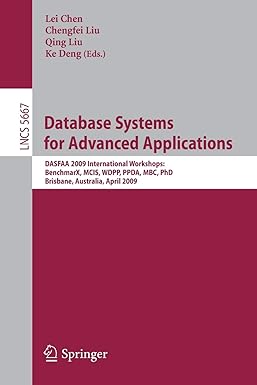Question
The objective of the Course Project is to give you practice applying the programming techniques to a complete development project. The actual programming problem is
The objective of the Course Project is to give you practice applying the programming techniques to a complete development project.
The actual programming problem is not too difficult, but in order to be successful with the Course Project, you will need to be able to apply the programming techniques and accomplish the analysis and design of the problem as well. This implies that you need to understand the weekly concepts as well as the programming techniques so you can apply both to the software development project.
Your final project must include all of the following. Your initial submission will start simple, and you will add features each week.
Input and output
Use of variables
Use of conditional statements
Use of loops
Use of modules
Use of arrays
Ability to save and retrieve data
For this project, you will decide on a program to write and develop it throughout the course. Select from one of the following cases, or use a case of your choosing. If you pick your own case, it must meet the above requirements and must be approved by your instructor.
The suggested project is a programming tutorial that will teach the user basic programming skills. As you develop the project, you will add the ability to quiz the user, modularize the code, and allow for saving of the student's data.
As an alternative, you can select a program related to your major or an interest of yours. See the following example.
Financial Calculator: You will develop a program for a bank that will allow it to process loans for customers. The user will enter information, such as interest rate, length of loan, amount borrowed, or desired payment, and the program will compute the missing information. It will also be able to display a report showing the amortization schedule for the loan. Customer data should be able to be saved and retrieved from a file or files.
Week 1: Decide on your project program, and write a brief description of what the program will do. Prepare an IPO chart for your program. Create two or three sample screens (using Word or a drawing program) depicting what your program will look like to the user (remember that these will be console-based programs).
Week 2: Create a flowchart for a simplified version of your program. Create a working version of it based on your flowchart. This should be a working program that accepts user input, does some calculation, and shows the results. It does not have to use conditional expressions, loops, and the like.
Examples: For the programming tutorial, you can describe and demonstrate to the user using screen output, how to declare variables, display information on the screen, get information from the user, and do calculations. You can ask the user for their name and include it in the tutorial output.
For a loan payment calculator, it asks for interest rate, length of loan, amount of loan, and it displays monthly payment. For a DJ manager, it asks for the average song length and the number of songs on a playlist, and it displays the length of the playlist.
Week 3: Add at least one conditional expression to your program.
Examples: In the programming tutorial, you would add a tutorial on conditional expressions. You can then add simple multiple choice questions to test the user's understanding of the concepts. You might also want to break the tutorial into sections, and use conditional expressions to ask the user which tutorial they wanted to see (i.e., variable declaration, input/output, conditional expressions, etc.).
For the loan calculator, the program might ask the user if he or she wants to solve for monthly payment, loan amount, length of loan, or interest rate. The program would then ask for the required information and solve for the remaining value.
Week 4: Add loops to validate data. Add a menu to your program that allows users to use the various features or exit the program.
Examples: In the programming tutorial, add a tutorial on working with loops. Then use loops to validate user input and display an error message if they enter data outside the valid range. Use a main loop to allow the user to keep selecting different tutorials until they decide to exit the program.
Week 5: Add arrays to your program to handle more data.
Examples: In the programming tutorial, add a tutorial on working with arrays. Then use arrays to store the answers to multiple questions so that you can compute a total score.
In the DJ program, you can add the ability to handle multiple songs and playlists. The electrical program should handle multiple customer scenarios.
Week 6: Create a hierarchy chart showing the logical components of your program. Modularize your code according to your chart using the practices learned this week. Your menu should now call individual modules to do the work of the program.
Examples: In the programming tutorial, add a tutorial on working with modules. Then modularize the code so that each tutorial and quiz is in a module.
Week 7: Add the ability to save data to disk in one or more files. The menu(s) should give the user the option to save or retrieve data.
Examples: In the programming tutorial, add a tutorial on working with files. Then add the ability to save/retrieve user information or quiz results.
Step by Step Solution
There are 3 Steps involved in it
Step: 1

Get Instant Access to Expert-Tailored Solutions
See step-by-step solutions with expert insights and AI powered tools for academic success
Step: 2

Step: 3

Ace Your Homework with AI
Get the answers you need in no time with our AI-driven, step-by-step assistance
Get Started


